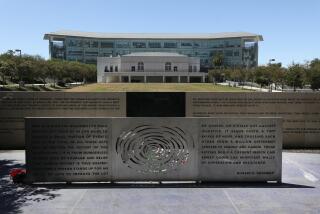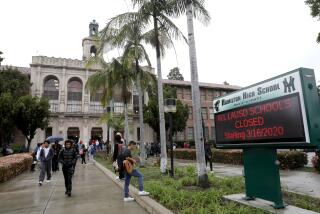Hearing Set in Wake of Redondo’s Unification Stand : Manhattan Beach Schools to Review Options
- Share via
The Manhattan Beach school board has scheduled a public hearing Wednesday night to review its school unification options in the wake of Redondo Beach’s recent decision to set up a separate system for its own grade and high school students.
Manhattan Beach officials said they plan to commission an independent study of all the options that were available before Redondo Beach decided to go it alone. One alternative, they said, would be to fight the Redondo Beach plan, which must get approval from the state Board of Education and voters.
The hearing will begin at 8 p.m. in the Begg Education Center, 1501 Redondo Ave.
The districts involved in the unification issue are the three elementary systems in Manhattan Beach, Redondo Beach and Hermosa Beach, and the South Bay Union High School District that serves the three cities.
All of the districts except Redondo Beach have said they will support the study, which is expected to take about three months. They plan to select a consultant at a May 8 meeting.
If the study determines that Redondo Beach’s decision could lead to a lower quality of education for students in other beach cities, Manhattan Beach and South Bay Union officials said, an effort will be made to block the Redondo Beach plan.
A major concern is that Mira Costa, the high school in Manhattan Beach, may lose at least 500 students, making the campus too small to support current programs. Enrollment at Mira Costa has been maintained at the 1,500-student level by assigning youngsters from the northern part of Redondo Beach to that campus. Redondo Union High School serves 1,600 students in Manhattan Beach, Redondo Beach and Hermosa Beach.
Earlier this month, the Redondo Beach board broke off discussions with the other districts and announced that it would go for what is being called “the split-unification approach.” It plans to form a K-12 system within its city boundaries that combines elementary schools in Redondo Beach with Redondo Union, serving about 5,600 children. Redondo Beach has about 5,600 children who go to public schools.
If successful, that plan would oblige Manhattan Beach to follow essentially the same path in its city. It would take over Mira Costa and set up a K-12 system within its city boundaries, drawing on its approximately 3,500 school-age children.
The tiny, one-school Hermosa elementary district, with 700 students, would be left with the choice of joining one of the new unified systems. About 100 Hermosa Beach youngsters go to Redondo Union.
“We think that Redondo jumped the gun,” Manhattan Beach Supt. Douglas Keeler said Friday. “There are tremendous, long-term implications in these decisions, and if Redondo’s action is clearly not in the best interests of Manhattan Beach students, I think we’re going to fight it.”
Efforts to block a separate Redondo Beach unification, he said, could include appeals to the county and state agencies that have jurisdiction over school unifications.
But, Keeler added, nobody knows yet whether Manhattan Beach students would be adversely affected by a split unification. “That’s one reason we need an independent, objective study,” he said. If the study shows that a consolidation of all the districts is best in financial and educational terms, he said, then voters in Redondo Beach may not want to approve their board’s plan.
“That may be a fond hope or dream” in Manhattan Beach, said Redondo Beach school board President Rebecca Sargent. “But it will never happen. We are going forward. . . . Our community is really serious about having our own school system and controlling our own destiny.”
Sargent said unification of all four districts was first proposed by South Bay Union officials in January as a solution to the high school district’s financial problems. “There was talk about (South Bay Union) going bankrupt or closing one of the high schools,” she said, adding that Redondo wants to set up its own unified district before that happens.
Walter Hale, superintendent of the South Bay Union district, said “it is totally incorrect that we are facing bankruptcy or that we might close a school. Our board has denied that at least a half dozen times publicly.”
He suggested that “these emotional rumors” may be spread as a “way of ensuring support for the split-unification solution.” It is true, he said, that the high school district is losing 25% of its student population over a four-year period, which results in lower state funding for the school, based on average daily attendance.
But, he said, “there is a light at the end of the tunnel. Enrollment will stabilize at about 3,000 students by 1991 and then we’ll be back on an even keel financially.”
In the meantime, to cover projected budget deficits over the next two years, he said, the district is seeking a state waiver that will allow it to use about $1.8 million from the sale of Aviation High School in 1984. The principal from the sale, now at $14.5 million, cannot be used without the waiver, which Hale said the district expects to get in May.
The unification process begins officially when 25% of the registered voters in a community approve a petition seeking unification. The petition is then reviewed by the county Committee on School District Organization and the state Board of Education.
If the state agency finds that the petition meets legal criteria, it may approve the plan and set an election in the cities that would be affected.
The entire process usually takes from two to three years.
More to Read
Sign up for Essential California
The most important California stories and recommendations in your inbox every morning.
You may occasionally receive promotional content from the Los Angeles Times.










